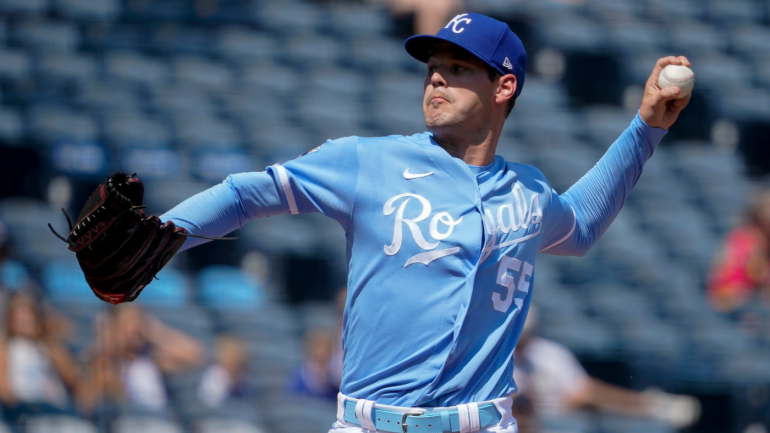
Only two weeks and four days remain in the 2023 MLB regular season and, thus far, the Braves are the only team to clinch a postseason berth. The Dodgers, Orioles, and Rays will follow fairly soon. All the other division and wild-card races are much tighter and could come down to the final weekend. The fan in me hopes they do.
Our bi-weekly series breaking down various trends across the league continues Wednesday with a look at a breakout pitcher and a breakout hitter, and a pitcher whose platoon splits could make him a valuable postseason weapon. Two weeks ago we examined the unclutch Padres, the Nationals' improved defense, and Carlos Correa's double play problem.
Ragans breaking out in Kansas City
Sunday afternoon, the Royals became the first team to lose 100 games this season. Yes, they managed to beat the Athletics to that benchmark. The loss came about because rookie lefty Cole Ragans, who came over in the Aroldis Chapman trade with the Rangers, uncorked three consecutive wild pitches to score two runs. Ouch.
"Pretty aggravating. We score two runs in the top (of the inning) and then I give them right back," Ragans told MLB.com after the game. "... I have no idea (how that happened). I've never had it happen to me. I don't know, it was kind of a freak accident. My spike just caught the mound, and I have to throw the ball or it's a balk, so it's just a tough spot."
The wild pitches and 100th loss overshadowed Ragans' 26-inning scoreless streak, part of an ace-level pitching performance since being called up by Kansas City on July 15. In nine starts, the 25-year-old southpaw has a 1.69 ERA with 69 strikeouts in 53 1/2 innings, and he's held opponents to a .192/.261/.239 batting line. That's as good a nine-start stretch as any pitcher has had in 2023.
Ragans, the No. 30 overall pick in the 2016 draft, did not pitch at all from 2018-20 because of two Tommy John surgeries and the pandemic. He reached the big leagues last August and went up and down with Texas. He's never lacked ability -- Ragans touched 97 mph with a knockout changeup and a good curveball as a prospect -- just durability.
With the Royals, Ragans has averaged 96.7 mph with his fastball and topped out at 101.0 mph. The swing and miss rate on his changeup is approaching 40%, which is top of the line. It's only nine starts, but gosh, what a nine starts it has been.
As detailed by The Athletic, Ragans' breakout dates back to last offseason, when he worked with a private pitching coach and went through biomechanical evaluation. Long story short, Ragans improved his mechanics, specifically incorporating his lower half a bit more, and both his stuff and command ticked up. Good work by Texas letting him work with an outside coach (some teams don't like that) and good work by the Royals identifying Ragans as a breakout candidate.
The Royals are on pace to shatter the franchise record of 106 losses set back in 2005. This has not been a good year in Kansas City, but Bobby Witt Jr is breaking out, and so is Ragans. Those are two pretty excellent bright spots in an otherwise lost season. The Royals look like they have a keeper in this very hard-throwing southpaw.
Hayes finally putting it together offensively
This past weekend, Pirates third baseman Ke'Bryan Hayes made headlines when he called out home plate umpire Bill Miller for a rather egregious missed call in Sunday's game. Miller called a 3-1 pitch that was well outside the zone a strike, extending the at-bat, and Hayes eventually struck out when he should have walked on the 3-1 pitch.
The incident with Miller should not be what is most remembered about Hayes' 2023 season. This season should be remembered as the year Hayes finally broke out as a hitter, and became the cornerstone player Pittsburgh envisioned with they signed him to an eight-year, $60 million extension last April. Games like his Sept. 4 effort against the Brewers are becoming the norm:
Hayes missed just about all of July with a lower back issue and, when he returned, he went 1 for 16 with five strikeouts in his first four games. Since then though, Hayes has been on a rampage: .317/.368/.610 with eight doubles and eight home runs in 30 games entering Tuesday. He struck out in only 17.3% of his plate appearances in those 30 games, well below the 22.6% league average.
There has been an important change in Hayes' batted ball tendencies since he came off the injured list, and those changes are a tangible reason to believe in his newfound level of production. Here are the numbers:
| Ground ball rate | Pull rate | |
|---|---|---|
2021 | 56.7% | 24.2% |
2022 | 49.4% | 27.0% |
2023 before IL | 43.4% | 27.9% |
2023 after IL | 42.7% | 38.2% |
MLB average for RHB | 42.9% | 41.1% |
Hayes was an extreme ground ball hitter earlier in his career. He has gradually cut down on the grounders and gotten the ball in the air more often, including this year before going on the injured list. Hayes was one of the most extreme ground ball hitters in the game in 2021. Now he's about league average, which isn't great, but is a lot better than where he was two years ago.
The most significant change is how often Hayes is pulling the ball. Pulling the ball has a negative connotation these days because of the shift, but it is the best way to generate power, and Hayes is pulling the ball much more often since returning from the back injury. He attributes this to a slight adjustment with his leg kick and timing mechanism. From MLB.com last month:
Hayes said he has made it a point of emphasis this season to get behind the ball better by getting his front foot down so he can put the barrel out in front.
So far, it's working.
"I'm just trying to do the same thing every day and go about my work the same way," Hayes said. "Try to be on time and swing at the pitches I want to swing at. [I'm] trying to go up there and get a good pitch to hit and hit it hard."
Hayes has always flashed strong underlying offensive skills. He was part of the exclusive 90/90 club in 2021 and 2022, referring to a 90 mph average exit velocity and 90% in-zone contact rate. Only a handful of players are consistent 90/90 hitters and they are generally the best hitters in the sport: Mookie Betts, José Ramírez, etc. Hayes hits the ball as hard and as often as them.
The ground balls muted his production, however, as did his tendency to use the big part of the outfield (up the middle). Now he's getting the ball in the air more often and he's pulling the ball down the line more often, leading to an uptick in power production. Hayes is tapping into his natural hard-hit ability and contact skills, and showing the type of hitter he can be.
Hayes is still only 26 and he is a brilliant defender at third base. Since 2020, he leads all players at all positions with 64 defensive runs saved (21 more than runner-up Michael A. Taylor) and is second with 48 outs above average (five behind leader Francisco Lindor). He would be immensely valuable with only a league average bat, which is more or less what he was from 2021-22.
But, if Hayes can continue pulling the ball in the air, he has legitimate star potential. He's been one of the best players in the game since returning from the injured list and has still only scratched the surface of his offensive ability. The Pirates have had another disappointing year and have yet to really take a step forward as part of their rebuild, but Hayes' breakout is exciting for a team desperate for a franchise type player. He's showing signs of becoming that guy.
Woo's extreme platoon splits
Injuries to Marco Gonzales and Robbie Ray forced the Mariners to dip deep into their farm system for pitching reinforcements this season and, by and large, the fill-ins have been solid. Rookies Emerson Hancock, Easton McGee, Bryce Miller, and Bryan Woo have combined to put up a 4.10 ERA and 2.1 WAR in 40 starts and 200 2/3 innings. That's not amazing, but for four rookie pitchers, that is fine production. The rookie starters have helped keep the Mariners afloat in the postseason race.
Miller (22 starts) and Woo (14 starts) account for the majority of those 40 starts and, assuming Seattle qualifies for the postseason, they figure to factor into postseason pitching staff somehow. Luis Castillo, George Kirby, and Logan Gilbert will be the top three starters in whatever order. We know that much. The No. 4 starter might be a bullpen game or mix-and-match situation. The Mariners will worry about that when they get there.
The 23-year-old Woo entered Tuesday's start with a 4.50 ERA in 14 starts and 70 innings. He also has extreme platoon splits, some of the most extreme you'll find in this game. Look at his numbers against lefties and righties entering Tuesday's start:
| PA | AVG/OBP/SLG | K% | BB% | GB% | HR/9 | |
|---|---|---|---|---|---|---|
vs. RHP | 156 | .164/.213/.226 | 28.8% | 3.8% | 52.5% | 0.44 |
vs. LHB | 139 | .311/.403/.588 | 16.5% | 11.5% | 26.0% | 2.20 |
Woo, a righty, has dominated right-handed batters. Lefties have dominated him though. Every lefty Woo has faced this season has turned into Freddie Freeman, more or less. That's how much success they've had against him. Against righties, Woo's your guy. You want him on the mound. Against lefties though? Eh, it might be time to look to the bullpen.
Even as a starter, Woo throws about 75% four-seam and two-seam fastballs. Add in 12% cutters, 10% sliders, and 3% changeups, and you have a very fastball heavy starter. Woo excels at running the four-seamer up in the zone and the two-seamer in on the hands of righties, like this:
That two-seamer that runs in the righty's hands is just nasty. The hitter's best case scenario for the hitter there is what, fouling that pitch into his leg? Shattering his bat and hitting a weak grounder? You needn't try hard to see how Woo, with his electric bat-missing fastball and ability to shut down righties, could be a weapon on October, particularly out of the bullpen.
Consider a possible postseason matchup with the Blue Jays. The top of Toronto's regular lineup typically goes George Springer, Bo Bichette, Brandon Belt, Vladimir Guerrero Jr. in that order. Managers like to find "lanes" for relievers, meaning pockets of the opposing lineup where a reliever matches up best, and Woo's ability to dominate righties appears to match up well with the top of the Blue Jays lineup. You have to worry about the lefty-hitting Belt, sure, but the other three are righties.
Long-term, Woo will have to figure out a way to neutralize lefties to remain a big-league starter. Maybe he refines his changeup or becomes more comfortable busting them inside with the cutter, something like that. Either way, Woo will have to make an adjustment to stay in the rotation. For now though, his extreme splits make him a potentially excellent matchup option in the postseason. There will be ways to leverage Woo's ability to shut down righties out of the bullpen.
























